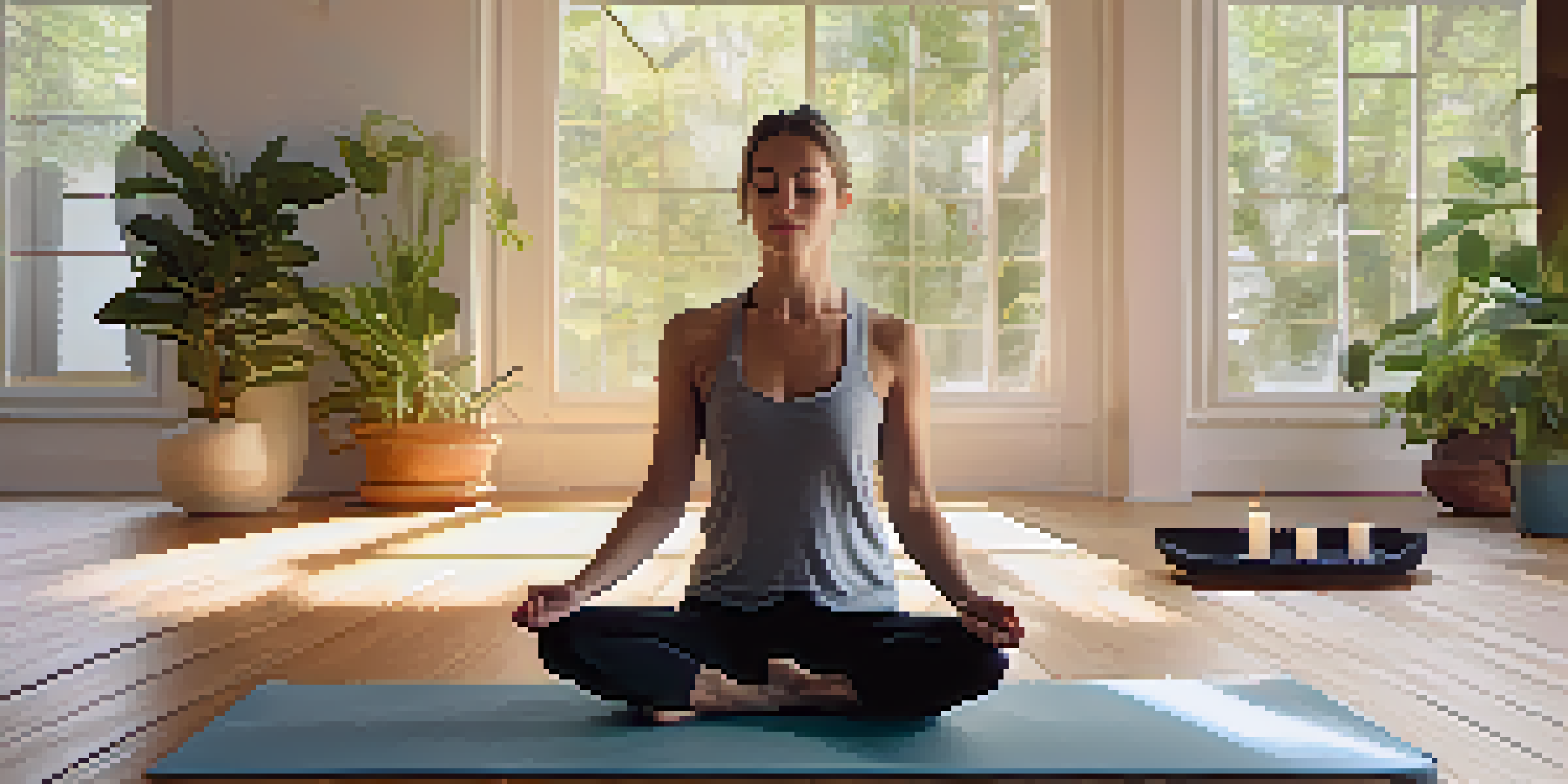Yoga Breathing Techniques for Enhanced Self-Care

Understanding the Importance of Breath in Yoga
Breath is fundamental in yoga, serving as the bridge between body and mind. It’s not just about the physical poses; the way we breathe can significantly impact our mental state and overall well-being. When we focus on our breath, we invite a sense of calm and clarity, helping us navigate daily stressors more effectively.
The breath is the bridge which connects life to consciousness, which unites your body to your thoughts.
Moreover, proper breathing techniques can enhance our yoga practice, allowing us to hold poses longer and with greater ease. This focus on breath encourages mindfulness, helping us stay present in the moment rather than getting lost in distractions. It’s like turning down the volume on life’s chaos and tuning into our inner self.
Incorporating breath awareness into our routine can transform our self-care practices. Whether you're at a yoga class or simply sitting quietly at home, being conscious of your breath can help cultivate a profound sense of peace and relaxation.
Exploring Diaphragmatic Breathing for Relaxation
Diaphragmatic breathing, also known as abdominal or belly breathing, is a powerful technique for relaxation. This method involves engaging the diaphragm fully, allowing your lungs to expand and contract more efficiently. By focusing on this deep style of breathing, you can lower stress levels and promote a sense of tranquility.

To practice diaphragmatic breathing, find a comfortable position. Place one hand on your chest and the other on your belly. Inhale deeply through your nose, ensuring your belly rises more than your chest. Exhale slowly through your mouth, feeling your belly fall. This simple practice can be a game-changer for anyone seeking to enhance their self-care routine.
Breath Connects Body and Mind
Focusing on breath in yoga enhances mental clarity and emotional well-being.
Regular practice of diaphragmatic breathing can lead to improved emotional regulation and mental clarity. It's a technique you can use anytime, anywhere—whether you're at work, home, or even stuck in traffic. Just a few minutes can make a significant difference in your day.
Nadi Shodhana: The Art of Alternate Nostril Breathing
Nadi Shodhana, or alternate nostril breathing, is a traditional yogic practice that helps balance the mind and body. This technique involves breathing through one nostril at a time, promoting a sense of calm and enhancing focus. It’s particularly useful for those feeling overwhelmed or anxious, as it helps to clear mental fog.
Breath is the finest gift of nature. Be grateful for this wonderful gift.
To practice, sit comfortably and use your thumb to close your right nostril. Inhale deeply through your left nostril, then close it with your ring finger. Release your thumb and exhale through the right nostril. Repeat this cycle for several minutes. Many find that it not only calms the mind but also energizes the body, making it a perfect self-care tool.
Incorporating Nadi Shodhana into your daily routine can help you feel more centered and grounded. It’s a wonderful way to reconnect with yourself throughout a busy day, providing a mental reset whenever you need it.
Box Breathing: A Simple Technique for Stress Relief
Box breathing, inspired by the rhythm of a box, is a simple yet highly effective technique for stress relief. This practice involves inhaling, holding the breath, exhaling, and holding the breath again—each for a count of four. It’s a great way to calm your nervous system and regain focus when life feels overwhelming.
Imagine drawing a box in your mind as you breathe: inhale for four counts, hold for four, exhale for four, and hold again for four. This structured approach to breathing can be particularly helpful during high-pressure situations, helping you regain a sense of control and clarity.
Diaphragmatic Breathing for Calm
This technique promotes relaxation and emotional regulation through deep, conscious breathing.
The beauty of box breathing is its accessibility; it can be done anywhere, at any time. Just a few minutes can help you feel grounded and ready to tackle whatever lies ahead.
Ujjayi Breathing: The Oceanic Breath
Ujjayi breathing, often referred to as 'oceanic breath' due to the sound it creates, is a technique widely used in yoga to enhance focus and presence. This method involves slightly constricting the throat while breathing, producing a soothing sound reminiscent of ocean waves. It's perfect for those looking to deepen their practice and enhance relaxation.
To practice Ujjayi breathing, inhale deeply through your nose, allowing your belly and chest to expand. As you exhale, constrict your throat gently, creating that signature sound. This technique not only helps in maintaining rhythm during yoga poses but also brings about a meditative state, enhancing your self-care routine.
Many yogis find that Ujjayi breathing improves their endurance and concentration during their practice. It’s a wonderful way to connect with your breath, making every inhale and exhale a mindful experience.
Kapalabhati: The Energizing Breath Technique
Kapalabhati, or 'skull shining breath,' is an energizing breathing technique that can provide an instant boost to your energy levels. Unlike other techniques that focus on relaxation, Kapalabhati emphasizes quick, forceful exhales followed by passive inhales. It’s great for those mornings when you need a little extra motivation to start your day.
To practice Kapalabhati, sit comfortably and take a deep inhale. Then, exhale sharply through your nose while pulling your belly inwards. Allow your inhale to happen naturally without effort. This technique not only invigorates the body but also clears the mind, making it an excellent self-care practice before a busy day.
Create a Personal Breath Practice
Establishing a consistent breath practice can significantly enhance self-care and overall health.
Incorporating Kapalabhati into your routine can help improve respiratory function and stimulate digestion. Just a few rounds can leave you feeling refreshed and ready to take on the world.
The Role of Breath in Mindfulness and Meditation
Breath plays a vital role in mindfulness and meditation, serving as an anchor to the present moment. By focusing on our breath, we can cultivate a deeper awareness of our thoughts and feelings. This practice helps reduce anxiety and promotes a greater sense of overall well-being.
During meditation, bring your attention to your breath, noticing each inhale and exhale. If your mind wanders, gently guide it back to the rhythm of your breathing. This simple act can create a profound shift in your mental state, fostering clarity and peace.

Integrating breath awareness into your mindfulness practice can enhance your self-care routine. It encourages a deeper connection with yourself and helps cultivate a sense of inner calm amidst life’s chaos.
Creating a Personal Breath Practice for Self-Care
Establishing a personal breath practice is a wonderful way to prioritize self-care and enhance your well-being. Start by exploring different techniques to see what resonates with you—whether it’s diaphragmatic breathing or Nadi Shodhana, find what feels right. Consistency is key, so aim to incorporate your chosen technique into your daily routine.
Consider setting aside a few minutes each day for your breathing practice. You can do this in the morning to set a positive tone for the day, during a midday break to recharge, or in the evening to unwind. The flexibility of breath work allows you to tailor it to your lifestyle and needs.
Remember, the goal is to create a practice that feels nourishing and supportive. Over time, you may find that these moments of breath awareness become a cherished part of your self-care routine, leading to greater emotional resilience and overall well-being.